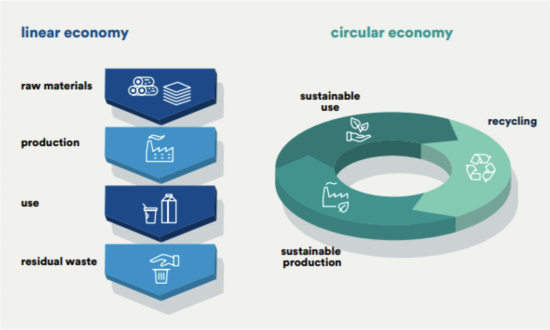Recently, I had the honor of attending a brief lecture led by Dr. Karl Aspelund, an associate director and professor who specializes in textile design and sustainability. After a thought-provoking discussion, Dr. Aspelund’s assertion that “there is no such thing as waste, [it] is simply matter in the wrong place,” sparked my interest in the idea of a circular economy.
First coined by Walter R. Stahel and Genevieve Reday-Mulvey in 1981, a circular economy is a proposed model of production, but what does that mean exactly? The Ellen MacArthur Foundation, an organization focused on accelerating the transition to a circular economy, defines it as “a system where materials never become waste…[and] products are kept in circulation through processes like maintenance, reuse, refurbishment, remanufacture, recycling, and composting.” Currently, our system of production and consumption is completely linear. Clothing is produced, distributed, used, then discarded.
This idea of a circular economy is based on the concept of keeping products in circulation for as long as possible while being regenerative in design. This enables the “recycling” of products that would otherwise be discarded. Hypothetically, after a piece of clothing can no longer be used for its original function, a circular economy proposes that its design should allow it to be used in manufacturing new materials and products. Not only will this decrease the volume of waste, but it has the potential to eliminate linear production through redesigning and regenerating clothing. According to the Ellen MacArthur Foundation, not only has the production rate of clothing doubled in the last fifteen years, but the lifespan of clothing has declined by nearly 40%. These statistics are both a consequence of the “fast fashion” phenomenon.
Fast fashion revolves around harnessing the rapid turnaround of celebrity trends and remarketing them to the general public. Although these products are inexpensive, it is often at the expense of quality and ethics. Most fast fashion items are estimated to be disposed of in under a year due to poor quality and lack of use. Extensive waste combined with our linear system of consumption is degrading our environment with its reliance on mainly non-renewable materials. This is a problem because precious resources, such as petroleum and fossil fuels, are being wasted on making clothing that is largely lost to landfill or incineration after a few years.
It is important to consider that excess is the result of the skewed notion of how price relates to worth. The 2020 Global Fashion Conference concludes that sustainable fashion is more expensive on average, and fast fashion buyers are not willing or able to pay for its worth. Considering the largest fast-fashion demographic makes roughly 15 to 17 dollars per hour, the more expensive sustainable fashion can seem like a greater waste. Unfortunately, the belief that a less expensive item helps save money is misguided as it neglects to consider how sustainable fashion has the advantage of long-term durability.
Obviously, recycling isn’t a new or revolutionary topic, but if everyone was aware of the benefits of a circular economy, we could re-envision our society and begin to solve issues with production waste, while steering away from the toxic fast fashion culture.
Works Cited:
EMA Foundation. “Fashion and the circular economy – deep dive.” Ellen MacArthur Foundation, 2021, https://www.ellenmacarthurfoundation.org/fashion-and-the-circular-economy-deep-dive. Accessed 23 January 2024.
EMA Foundation. “What is a circular economy?” Ellen MacArthur Foundation, 2021, https://www.ellenmacarthurfoundation.org/topics/circular-economy-introduction/overview. Accessed 23 January 2024.
EPA. “What is a Circular Economy? | US EPA.” Environmental Protection Agency (EPA), 14 December 2023, https://www.epa.gov/circulareconomy/what-circular-economy. Accessed 23 January 2024.
Haan, Katherine. “Average Salary by Age In 2024 – Forbes Advisor.” Forbes, 23 May 2023, https://www.forbes.com/advisor/business/average-salary-by-age/. Accessed 23 January 2024.
Petrini, Carlo. “The consumption side of sustainable fashion: price sensitivity, value and transparency demand Silvia Blas Riesgo Universidad de Navarra, Spain.” Global Fashion Conference, 2020, https://gfc-conference.eu/wp-content/uploads/2020/11/BLAS-RIESGO-ET-AL_The-consumption-side-of-sustainable-fashion-price-sensitivity-value-and-transparency-demand.pdf. Accessed 23 January 2024.
Sampson, Eirini. “Is fast fashion about self-expression or consumerism?” Sustainability for Students, 13 October 2022, https://www.sustainabilityforstudents.com/post/is-fast-fashion-about-self-expression-or-consumerism. Accessed 23 January 2024.
Stahel, Walter R., et al. “(PDF) Jobs for tomorrow: the potential for substituting manpower for energy.” ResearchGate, 1981, https://www.researchgate.net/publication/40935606_Jobs_for_tomorrow_the_potential_for_substituting_manpower_for_energy. Accessed 23 January 2024.











